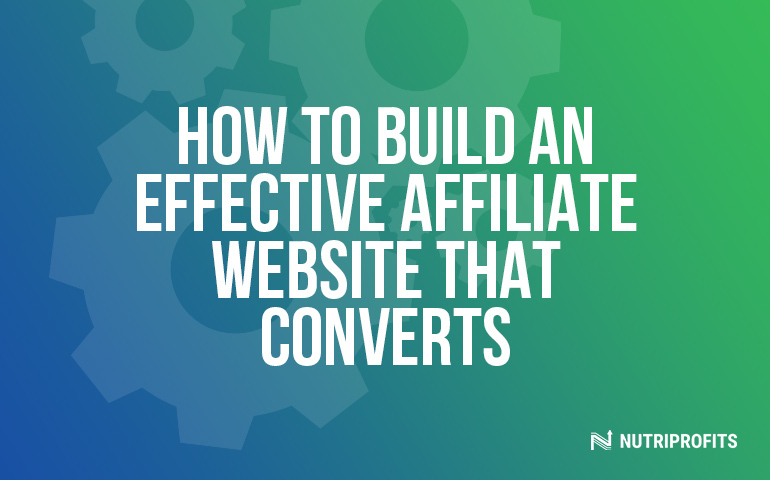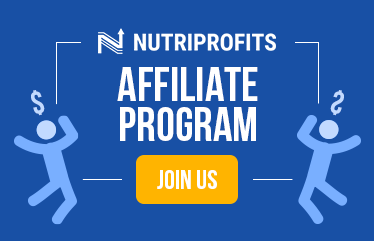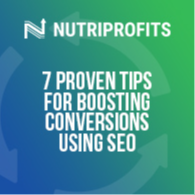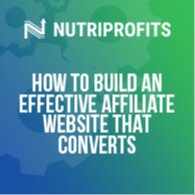Affiliate marketing is one of the most popular ways to earn money online. However, it’s not as easy as posting your link and watching the sales pour in. Your success as an affiliate marketer depends heavily on the way your affiliate website is designed.
There’s a bit more to building an effective affiliate website than whipping up a pretty landing page — though that’s part of it. Your website needs to be thoroughly optimized to attract relevant visitors (visitors who are searching for what you’re selling) and funnel them toward converting (making a purchase through your link).
That’s why in this article, we’re going to take you through the essential steps to build an effective affiliate marketing website that actually converts. Whether you’re brand new to affiliate marketing or an experienced affiliate marketer looking to rejuvenate your website’s performance, this is the guide for you.
We’ll cover everything from choosing a domain name, to crafting compelling content, to attracting and monitoring web traffic, to managing legal compliance, and much more. Along the way, we’ll provide you with some practical tips and examples to help you find success in the nutra affiliate market, specifically.
Let’s dive right in.

Getting Started: Choosing a Domain Name
Before you can start building your website, the first thing you’ll need to do is choose a domain name.
1. Make It Easy to Remember
A domain name is not just an online address — it’s also a marketing tool. Try to think of names that stand out and leave a lasting impression on your visitors. Short and catchy names are typically more memorable than long names, but a longer name can sometimes help distinguish your brand as long as it’s still easy to remember.
Example: Punchy, alliterative names like “saavysupplements.com” or “wellnesswizard.com” often work well because they’re easy to remember.
2. Make It Relevant
Keeping your domain name relevant to your market is important for two reasons. First, a relevant name ensures site visitors immediately understand what your website is about and what kind of products or information they’ll find on it, making them more likely to click.
Second, a relevant domain name provides search engines with the same information. The easier it is for search engine algorithms to detect and understand what your website is about, the higher it will rank in search engine results pages (SERPs) for related searches.
Example: A domain name like "supplementsguru.com" could work well in the supplements market because it directly states the purpose of the website and communicates expertise.
3. Keep It Simple
Choose a name that’s easy to spell and easy to pronounce. Avoid using complex or uncommon words to eliminate any chance of confusion for site visitors and to make it easier for them to remember your URL.
You should also avoid using hyphens or numbers in your domain name because they make it harder to remember and type, and they’re often associated with spammy or low-quality websites.
Example: Steer clear of names like “super-supplements-4-u.com” that contain numbers and hyphens and are hard to type.
4. Check Availability
Before you get too attached to your new domain name, make sure it's available! You can use domain registrars like GoDaddy to check availability. Be cautious about existing trademarks and take care to verify that your chosen domain name doesn't infringe on any existing properties.
Web Hosting Options
After you’ve chosen a domain name for your website, you’ll need to select a reliable web hosting provider. Consider factors like your expected traffic volume, the complexity of your website, and the types of content you'll be publishing (such as video content vs. mainly text-based posts).
Next, research popular hosting providers to find the one that best suits your needs. Look for a provider with multiple data centers worldwide (preferably including one near you) to ensure strong performance. You should also take into account the level of customer support offered by the provider — a robust support plan can sometimes make all the difference in getting your site up and running smoothly.
Pro Tip: Many affiliate marketers use services like Hostinger, HostGator, or UltaHost because they offer exceptional ease of use and reliable uptime for very affordable prices (often free). However, there are many other options as well.
Designing Your Affiliate Website
Once you have a domain and a web host, it’s time to design the structure and layout of your affiliate marketing site.
Website Structure
Your website’s structure is the way the pages that comprise it are arranged and linked together. A logical, user-friendly website structure is foundational to a successful affiliate marketing site (or any kind of site, for that matter).
Start by carefully planning your site’s navigation. Map out all the pages that will be included on the website and organize them in a way that flows naturally in the direction you want the visitor’s journey to take — ultimately toward clicking your affiliate link. It needs to be easy for site visitors to find the information they’re looking for, otherwise they won’t stick around for long.
Don’t forget to optimize your site for mobile devices, too. Not only are many of your customers likely to be browsing your site on-the-go, but Google is now prioritizing mobile-friendly sites in search results.
Website Layout
A visually appealing website layout is crucial for attracting viewers and holding their attention. Consistency is key here — make sure you use a uniform color scheme and a limited number of complementary fonts to establish a cohesive aesthetic across your website.
You can also enhance the visual appeal of your website by incorporating a mix of content styles, like embedded videos and graphics. Varied, high-quality visuals make your site more engaging for visitors and are great for quickly educating visitors about products.
However, don’t get too carried away with the eye-catching graphics. Remember that whitespace plays a vital role in your layout as well. There should be ample spacing between elements to keep content readable and create a clean, uncluttered look that’s easy for visitors to navigate.
Popular Tools for Building Websites
There’s no need to code your website from scratch — as you probably already know, there are countless website-building tools available for free or for a very affordable price. Here are a few of the best ones for affiliate marketers:
- WordPress is well-known for its flexibility and extensive customizability, making it an excellent choice for affiliate marketers looking to tailor their sites to a particular niche.
- Wix is a user-friendly, drag-and-drop website builder that’s a top pick for many beginners because it offers a wide range of templates to simplify the design process.
- Squarespace is another perfect fit for affiliate marketers who need a way to create appealing designs without delving too far into technical complexities. It offers a variety of beautifully designed templates and an intuitive website building tool.
Crafting Content for Conversions
Next, you’ll need to create content for your website. There are a few key considerations when crafting compelling and convincing web content (beyond the quality of your content itself, of course).
Writing For Your Target Audience
Successful high-converting content starts with a deep understanding of your target audience. To create content that resonates, you’ll need to develop a robust understanding of not only your audience's demographics (age, ethnicity, education, income, geographic location, etc.) but also their pain points.
In other words, what problems is your target audience experiencing that your affiliate products can solve? Writing content that addresses your target audience’s pain points and naturally guides them toward your solution (your affiliate link) is a great way to make effective content.
It’s also smart to develop customer personas. This means segmenting your whole target audience into smaller groups based on specific similarities. By creating personas that represent unique segments within your audience, you can tailor your content to match your site visitors’ needs and preferences even more closely — ultimately driving higher conversion rates across the board.
SEO Best Practices
Search engine optimization (SEO) is another crucial facet of online content creation. Optimizing your website to appeal to search engine algorithms gives your content a fighting chance against the sea of competition.
First of all, thorough keyword research is a must. Identify the keywords your target audience is using in search engines and strategically integrate those keywords into your content (tools like Google Keyword Planner or SEMrush will help you in this regard).
Additionally, vary the types of content you publish on your site, including product reviews, best-of lists, how-to articles, and more. Different types of content serve different user intents and provide opportunities to expose your affiliate website to a wider audience.
Legal Regulations and Compliance
Before we go any further, there are a few specific legal regulations in the affiliate marketing industry that every marketer must be aware of.
Affiliate Disclosures
Most importantly, you must explicitly disclose your affiliate relationships to your audience. This means you must clearly state in your affiliate marketing content that you receive a commission from purchases made through your affiliate link. It’s very important that this disclosure is clear, direct, and displayed prominently — not hidden in small text at the bottom of the page.
Data Privacy
Additionally, your website must comply with all applicable data protection laws, including notifying visitors about your site’s usage of cookies. Applicable data protection laws are determined by many factors, such as your geographic location, the affiliate program in which you’re participating, the type of product you’re promoting, and the platform you’re using to promote it.
Generating Traffic and Building an Audience
Once your affiliate marketing site is up and running (and fully compliant with the law), you can turn your attention toward generating traffic and building an audience. There are a few ways you can attract customers to your site. Some of the best channels to focus on are social media marketing, email marketing, organic traffic (SEO), and paid advertising.
Social Media Marketing
To market products on social media, begin by selecting the right platform(s) for your niche and target audience. Consider everything you know about your audience’s demographics, interests, preferences, and behaviors and use those factors to match with social media platforms that serve similar audiences.
For example, if you’re marketing supplements that are intended for middle-aged individuals, it would be helpful to know that Instagram’s largest user group by age is people between 18 and 24 — meaning you’d likely be wasting your time posting your affiliate content there.
Once you’ve selected your platforms, tailor your content strategy to the strengths and weaknesses of each one. Posting consistently and actively engaging with comments will help you earn genuine interaction from your audience that leads to conversions.
Email Marketing
Any effective email marketing strategy starts with a list of contacts. To build your email list, encourage website visitors to subscribe to your newsletter or set up lead magnets like free guides or reports. Once you’ve established a large enough list, segment it based on factors like demographics, interests, purchase histories, or level of engagement.
Then, craft engaging and informative email content that’s personalized for each segment. For instance, you can offer relevant product recommendations, tailored special offers, customized educational content, or personalized updates on industry trends. Ultimately, successful email marketing hinges on your ability to foster meaningful and lasting relationships with your subscribers.
SEO and Organic Traffic
Optimizing your content for search engines is an intentional and ongoing process. Pay close attention to the keywords you’re using, as well as how you’re incorporating your affiliate links into your content. Dropping in your links at random can cause search engines to see your content as confusing or low quality. To ensure this doesn’t happen, link your affiliate products to relevant anchor text that fits naturally within the content on the page.
Regularly updating the content on your affiliate website is another essential SEO practice. Keeping the information on your site up-to-date signals to search engine algorithms that your website is a reliable and authoritative source within your niche.
Paid Advertising
Paid advertising is a great way to get more eyes on your site, but it's not a magic spell — you’ll need to approach paid ads just as strategically as any other aspect of your affiliate marketing efforts if you want to see any payoff.
The most important step is analyzing the pros and cons of each advertising platform to determine the best fit for your niche and target audience. This is essentially the same process as analyzing which social media platform is best.
Pro Tip: NutriProfits affiliates tend to have the best success with Google Ads, Facebook Ads, TikTok Ads, and Push Ads.
Budget management is another important consideration when setting up paid advertising. Define your available budget and expected return on investment (ROI) for each platform up front, paying close attention to factors like estimated costs and conversion rates.
Monitoring and Optimization
Now that you have a working website and customers trickling in, you should start measuring your progress — that way you know what’s working and what needs to be improved.
Tracking Website Performance and User Behavior
Monitoring and optimizing your website begins with tracking your visitors’ behavior on your site and using that information to gauge your website's performance. There are a variety of tools you can use to gather these insights.
One of the most popular website monitoring tools is Google Analytics. It’s free to use and offers a comprehensive view of the metrics you’ll need to understand your site’s performance, including traffic, user engagement, and conversion data. There are many other free analytics tools as well, like Matomo, that you might find useful.
A/B Testing for Conversion Rate Optimization
Once you have the data insights you need, it’s time to put them to work. A/B testing is one of the best data-driven tactics you can use to optimize your website’s conversion rate. This involves directly comparing two different web page designs or content versions directly against one another to see which performs better. A/B testing is one of the most reliable ways to refine your website to achieve higher conversion rates because it forces you to base your decision-making on real user behavior.
Staying Ahead of Industry Trends
Online marketing evolves at lighting speed, as search engine algorithms and advertising regulations are both subject to change frequently. It’s in your best interests as an affiliate marketer to stay informed about what’s happening in the affiliate marketing industry and in the nutra/supplements industry so you can adapt your strategies quickly to stay ahead of the curve.
Key Takeaways
Let's recap the key steps you need to remember to build an effective affiliate website:
-
Choose a memorable domain name and reliable web hosting provider.
-
Design a user-friendly, mobile-responsive website.
-
Create engaging, audience-specific content that resonates with your target audience.
-
Comply with all legal regulations, such as disclosure requirements.
-
Drive traffic through relevant marketing channels like social media marketing, email marketing, SEO, and paid advertising.
-
Continuously monitor your website's performance and implement A/B testing to optimize conversions.
-
Stay up-to-date on industry trends and adapt to changes quickly.
A successful, high-converting affiliate website is not easy to build — however, with the right plan and some dedication, it’s a very attainable and rewarding goal. By implementing the strategies we’ve outlined in this article, you’ll be well on your way to earning a steady income through your affiliate links.





.jpg)

-1-1.jpg)